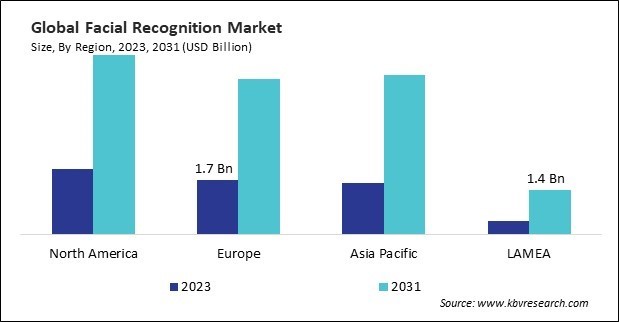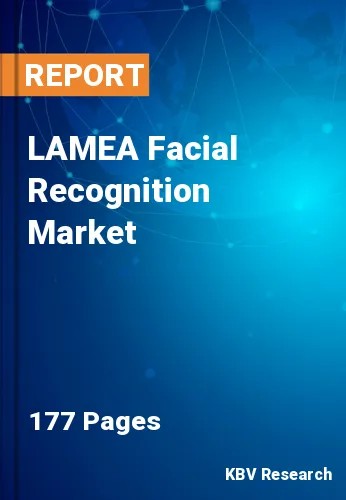The Facial Recognition Market is Predict to reach USD 16.8 billion by 2031, at a CAGR of 14.5%
Special Offering :
Industry Insights | Market Trends | Highest number of Tables | 24/7 Analyst Support
Facial Recognition Market Growth, Trends and Report Highlights
According to a new report, published by KBV research, The Global Facial Recognition Market size is expected to reach $16.8 billion by 2031, rising at a market growth of 14.5% CAGR during the forecast period.
The Large Enterprises segment dominated the Global Facial Recognition Market by Organization Size in 2023, thereby, achieving a market value of $11.9 billion by 2031. Large enterprises often have complex security requirements due to the scale of their operations, extensive physical infrastructure, and diverse workforce. Facial recognition technology offers advanced security solutions by accurately identifying individuals and granting access to restricted areas, thereby enhancing overall security measures. Hence, the segment will grow rapidly in the coming years.

The On-premises segment is showcasing a CAGR of 13.3 % during the forecast period. On-premises facial recognition solutions offer a higher level of security and control over sensitive data compared to cloud-based alternatives. Organizations, particularly those in sectors such as government, defense, and finance, prioritize data privacy and security concerns. Hence, these factors can boost the demand in the segment.
The Software segment dominated the Global Facial Recognition Market by Offering in 2023, thereby, achieving a market value of $6.95 billion by 2031. The continuous advancement of facial recognition algorithms and software technologies has fueled demand in the software segment. Innovations in machine learning, deep learning, and computer vision have led to the development of more accurate, efficient, and reliable facial recognition software solutions. These advancements enable software vendors to offer cutting-edge features such as real-time face detection, emotion recognition, and face matching with high accuracy and speed, driving adoption across industries. Therefore, these factors can help in the expansion of the segment.
The 3D segment is registering a CAGR of 14.7 % during the forecast period. 3D facial recognition technology captures depth information along with surface features, resulting in more accurate and reliable identification of individuals. By creating a three-dimensional representation of facial geometry, 3D facial recognition systems can overcome challenges associated with variations in lighting, pose, and facial expressions, leading to higher accuracy rates and reduced false positives. Hence, these aspects can lead to an increased demand in the segment.
The Access Control segment dominated the Global Facial Recognition Market by Application in 2023, thereby, achieving a market value of $6.3 billion by 2031. Access control solutions leveraging facial recognition technology can seamlessly integrate with existing security infrastructure, including surveillance systems, biometric access control devices, and visitor management systems. This integration facilitates centralized control and management of access rights, enabling organizations to monitor and regulate access to different areas within their premises efficiently. Hence, these factors can boost the demand in the segment.
The Government segment is growing at a CAGR of 12.3 % during the forecast period. Governments worldwide are increasingly adopting facial recognition technology for security and surveillance applications, including border control, law enforcement, and public safety. Facial recognition systems enable authorities to identify and track individuals in real-time, enhance situational awareness, and prevent security threats and criminal activities. Thus, owing to these factors, there will be enhanced demand in the segment.
Full Report: https://www.kbvresearch.com/facial-recognition-market/
The North America region dominated the Global Facial Recognition Market by Region in 2023, and would continue to be a dominant market till 2031; thereby, achieving a market value of $5.6 billion by 2031. The Europe region is poised to grow at a CAGR of 14.1% during (2024 - 2031). Additionally, The Asia Pacific region would witness a CAGR of 15.3% during (2024 - 2031).
List of Key Companies Profiled
- IDEMIA SAS (Advent International, Inc.)
- Microsoft Corporation
- NEC Corporation
- Thales Group S.A.
- 3M Company
- Cognitec Systems GmbH (Salto Systems, S.L.)
- Aware, Inc.
- Onfido Limited
- Animetrics
- Daon, Inc.
Facial Recognition Market Report Segmentation
By Organization Size
- Large Enterprises
- Small & Medium Enterprises
By Deployment Mode
- On-premises
- Cloud
By Offering
- Software
- Hardware
- Services
By Technology
- 3D
- 2D
- Facial Analytics
By Application
- Access Control
- Attendance Tracking & Monitoring
- Security & Surveillance
- Emotion Recognition
- Others
By Vertical
- Government
- Media & Entertainment
- Education
- Healthcare & Lifesciences
- Automobile & Transportation
- Manufacturing
- Retail & eCommerce
- IT & Telecom
- Others
By Geography
- North America
- US
- Canada
- Mexico
- Rest of North America
- Europe
- Germany
- UK
- France
- Russia
- Spain
- Italy
- Rest of Europe
- Asia Pacific
- China
- Japan
- India
- South Korea
- Singapore
- Malaysia
- Rest of Asia Pacific
- LAMEA
- Brazil
- Argentina
- UAE
- Saudi Arabia
- South Africa
- Nigeria
- Rest of LAMEA
Related Reports:



